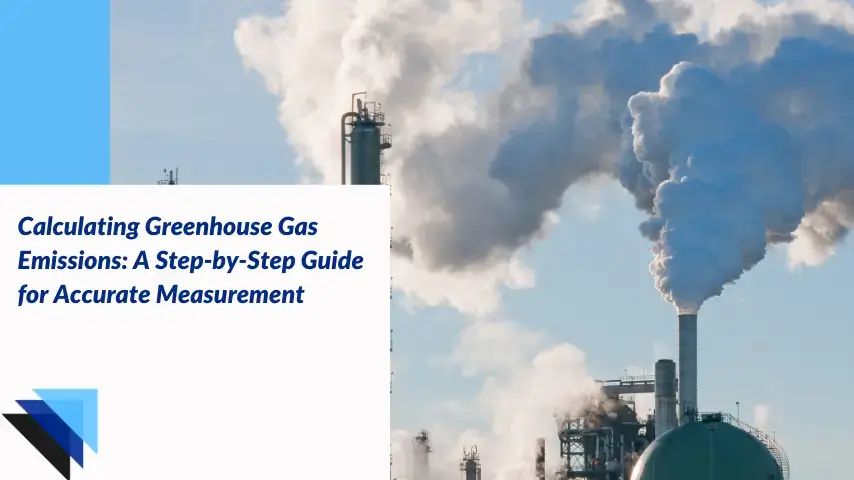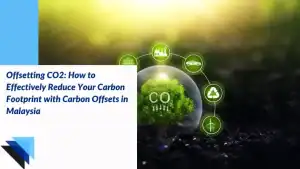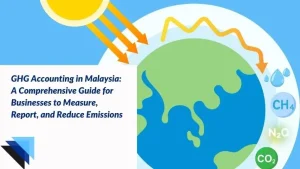Calculating Greenhouse Gas Emissions refers to the process of quantifying the amount of greenhouse gases, such as carbon dioxide (CO2), methane (CH4), and nitrous oxide (N2O), released into the atmosphere due to various activities. This involves identifying emission sources, collecting activity data, applying emission factors, and converting the results into a standardized unit, typically carbon dioxide equivalent (CO2e).
Calculating greenhouse gas emissions accurately is essential in the ongoing fight against climate change. Understanding the sources and amounts of carbon dioxide (CO₂) and other GHG emissions helps organizations and governments craft effective greenhouse gas reduction strategies. Thorough measurement supports emissions reduction targets, compliance with evolving regulations, and enhanced stakeholder trust. This comprehensive guide outlines the structured guidance, methodologies, and tools needed for precise emissions quantification, providing actionable insights for anyone invested in reducing their environmental impact.
Whether your goal is to perform a detailed carbon emissions analysis, align with the GHG Protocol, or simply find the right carbon footprint calculator, this article will empower you to measure, analyze, and report annual emissions with confidence, accuracy, and transparency.
Ready to Measure Your Carbon Footprint?
Begin your journey with expert support and the right tools tailored to your operations.
- Why Is Accurate Calculating Greenhouse Gas Emissions Important for Sustainability?
- What Are the Basics of Calculating Greenhouse Gas Emissions?
- What Are the Step-by-Step Procedures for Calculating Greenhouse Gas Emissions?
- What Tools and Software Are Available for Accurate GHG Emissions Quantification?
- What Are the Common Challenges When Calculating Greenhouse Gas Emissions?
- How Can Organizations Enhance Emission Reductions Using Best Practices?
- How Wellkinetics Can Help
Why Is Accurate Calculating Greenhouse Gas Emissions Important for Sustainability?
Data-driven approaches to quantifying greenhouse gas emissions underpin the transition to a more sustainable, low-carbon economy. Key statistics from the UNFCCC reveal that global CO₂ emission levels have risen by more than 60% since 1990, underscoring the urgent need for robust emission inventories and science-based reduction targets across sectors.
What Are the Key Benefits of Accurate Greenhouse Gas Emissions Calculations?
Accurate calculation of greenhouse gas emissions offers a range of benefits that help organizations not only meet compliance requirements but also implement effective reduction strategies and build trust with stakeholders. These benefits contribute to aligning efforts with broader climate commitments and driving meaningful progress in sustainability:
- Regulatory Compliance: Accurate emissions quantification helps organizations meet guidance on disclosures expected under frameworks such as the GHG Protocol, ISO 14064, and country-specific tools for emissions reporting.
- Targeted Emissions Reduction: Reliable identification of emission sources, such as stationary combustion sources, and downstream activities, enables focused greenhouse gas reduction strategy development.
- Enhanced Stakeholder Engagement: Transparent reporting, supported by cross-sector tools and sector-specific tools, builds investor confidence and public trust.
- Benchmarking for Climate Goals: Using detailed carbon emissions analysis and activity-based approach methodologies allows organizations to align efforts with national and international climate goals, such as those outlined in the Paris Agreement.
Also read: ESG Compliance: Regulatory Requirements, Reporting Standards & Best Practices in Malaysia
What Are the Basics of Calculating Greenhouse Gas Emissions?
Effective calculation of greenhouse gas emissions involves identifying and classifying emission sources, collecting reliable activity data, and applying relevant emission factors. GHG emissions stem from a variety of chemical processes, with carbon dioxide, methane, and nitrous oxide among the most prevalent gases tracked in emission inventories.
What Are the Different Types of Greenhouse Gas Emission Sources?
Greenhouse gas emission sources are typically categorized based on their origin and the processes that generate them. Understanding these categories is crucial for accurately measuring and managing emissions, as it enables targeted strategies to mitigate environmental impact.
- Scope 1 (Direct Control): All direct GHG emissions from sources like fuel combustion in company vehicles, boilers, and stationary combustion sources. Gas leaks from equipment are also considered here.
- Scope 2 (Purchased energy consumed): Indirect emissions from the consumption of purchased electricity, steam, and other forms of energy supplied by external providers.
- Scope 3 (Upstream & Downstream value-chain): All other indirect emissions such as those associated with supply chains, waste management, and downstream activities, are often the most complex and require careful carbon emissions analysis to quantify.
The Greenhouse Gas Protocol emphasizes a comprehensive approach, encouraging organizations to assess and disclose emissions sources across all three scopes to provide a complete picture of their level of impact and relation to environment.
RELATED: Carbon Management: Key Strategies and Best Practices for Reducing Emissions
Struggling with Scope 3 Emissions?
Let Wellkinetics help you quantify complex indirect emissions with precision.
What Are the Step-by-Step Procedures for Calculating Greenhouse Gas Emissions?
Consistent calculation and reporting of GHG emissions demand an organized, activity-based approach. The following process details each stage required for valid, reliable, and audit-ready emissions quantification.
Step 1: Establish Organizational and Operational Boundaries
Defining organizational boundaries, such as equity share, financial control, or operational control, sets the stage for which emission sources are included in the overall assessment.
Operational boundaries dictate which emission scopes, Scope 1, 2, or 3, are relevant to your organization’s activity-based approach and greenhouse gas reduction strategy.
Step 2: Identify and Collect Data on Emission Sources
Comprehensive emission inventories begin with a detailed list of emissions sources. Common examples include:
- Scope 1: Stationary combustion (boilers, furnaces, generators), mobile combustion (fleet), and fugitive emissions (e.g., refrigerants)
- Scope 2: Purchases from energy providers
- Scope 3: Downstream activities (e.g., product use by customers, end-of-life treatment), Supply chain emissions (e.g., purchased goods and services, transportation of materials), Waste disposal (e.g., landfill, recycling, incineration)
When collecting data, incorporate inputs from utility providers, transportation logs, supply chain partners, and waste management records.
Step 3: Quantify Activity Data for GHG Emissions
This step involves determining measurable quantities, such as fuel consumed (liters), electricity usage (kilowatt-hours), or material processed (tonnes). High-quality, verified activity data forms the core input for any basic formula or carbon calculator.
Step 4: Apply Appropriate Emission Factors and Conversion Formulas
Emission factors convert activity data into actual GHG emissions. These can be sourced from resources like the EPA’s Emission Factors Hub, IPCC guidelines, and sector-specific or country-specific such as Malaysia grid factors from Energy Commission.
Basic Formula Example
| tCO2e = Activity data × Emission factor × GWP | |||
| Tonnes of CO2 equivalent | How much of something is used or done (e.g., litres of fuel, kWh of electricity). | Factor to convert activities into comparable emissions. | A multiplier to compare different gases to CO₂. |
Applying the correct emission factors ensures accurate annual emissions calculation and effective benchmarking when performing carbon emissions analysis.
Step 5: Aggregate and Calculate Total Greenhouse Gas Emissions
Sum all reported emissions from the identified sources. Where possible, express total emissions in carbon dioxide equivalent (CO₂e) to standardize across gases with different warming impacts. Use carbon footprint calculators and dedicated software tools to facilitate mass emission rate computations across scopes 1, 2, and 3.
Step 6: Validate Results and Seek External Assurance
Double-check calculations by comparing emission inventories with previous years, using cross-sector tools for benchmarking, and, when possible, engaging third-party auditors. This step supports credible, transparent disclosure and strengthens confidence in your emissions reduction journey.
Step 7: Disclose and Report Your GHG Data
Prepare reports detailing emissions sources, basic formulas used, reduction targets, and your activity-based approach methodology. Adhering to structured guidance from frameworks like CDP, GRI, or the GHG Protocol ensures clear, comparable data and meets global expectations for climate change disclosure.
What Tools and Software Are Available for Accurate GHG Emissions Quantification?
Streamlining the calculation, aggregation, and reporting of GHG emissions is made easier by technological advancements and specialized platforms:
- GHG Protocol’s Calculation Tools: Offers modular sector-specific tools and guidance for comprehensive GHG emissions calculation.
- Carbon Calculator and Carbon Footprint Calculators: These tools, including online platforms and downloadable software, support organizations in estimating their annual emissions efficiently.
- Cross-Sector and Sector-Specific Tools: Choose resources tailored to your industry, such as those for power plants, manufacturing, or chemical processes.
- Country-Specific Tools: These incorporate local emission factors and legal requirements, essential for global enterprises and multinational reporting.
What Are the Common Challenges When Calculating Greenhouse Gas Emissions?
Calculating greenhouse gas (GHG) emissions is a complex process that involves numerous variables and considerations. Organizations often face challenges in data collection, accurate measurement, and adhering to evolving regulations. Understanding these obstacles is key to developing strategies for more effective and transparent reporting.
Data Gaps and Reliability
Accurate quantification relies on complete, verified data from all emission sources. Missing or estimated information, especially for Scope 3 and downstream activities, can diminish the reliability of carbon emissions analysis and complicate emissions reduction strategies.
Variation in Methodologies
Different sectors and countries may require the use of alternate emission factors, basic formulas, or unique tools. Aligning with international frameworks, such as the GHG Protocol, helps maintain consistency and comparability.
Resource and Cost Barriers
Obtaining robust emissions inventories may entail significant investments in staff, procurement of high-quality sector-specific tools, conducting frequent carbon emissions analysis, and even engaging in carbon offsetting or carbon offsetting projects to achieve climate goals.
How Can Organizations Enhance Emission Reductions Using Best Practices?
Adopting rigorous and transparent practices in emission quantification is essential for meaningful emissions reduction. The following best practices can help ensure accuracy and success:
- Regular audits and updates to emission inventories: Systematically reviewing and updating your organization’s emission inventories helps maintain data integrity and reflect changes in operations, fuel combustion patterns, or emission sources. For example, an annual review ensures that any new equipment, process modifications, or facilities are accounted for, minimizing data gaps and errors.
- Leveraging advanced carbon calculator tools for mass emission rate tracking: Utilizing modern carbon footprint calculators or industry-specific software platforms enables organizations to monitor GHG emissions in real time. These tools streamline emissions quantification, calculating CO₂ and other greenhouse gas outputs from stationary combustion sources, power plants, or chemical processes based on current activity data. This improve both accuracy and responsiveness to changes.
- Integrating an activity-based approach across all upstream and downstream activities: Adopting an activity-based approach ensures that both direct and indirect emissions are accurately quantified. This includes considering Scope 1, 2, and 3 emissions, ranging from direct fuel consumption to procurement from energy providers and emissions linked to downstream activities like product distribution and disposal. A structured approach helps identify all emission sources and facilitates comprehensive reporting.
- Setting science-based reduction targets in line with climate change mitigation strategies: Establishing clear, measurable reduction targets, aligned with international climate goals, ensures emissions reduction efforts are both ambitious and achievable. For instance, targets might be set based on GHG Protocol guidance, sectoral benchmarks, or country-specific pathways consistent with the Paris Agreement.
- Considering carbon offsetting and supporting local or global Carbon Offsetting Projects: Where direct emissions reductions are not feasible, organizations can invest in carbon offsetting by supporting projects that reduce or sequester greenhouse gases elsewhere, such as reforestation or methane capture initiatives. Well-documented Carbon Offsetting Projects not only compensate for unavoidable emissions but can also enhance corporate sustainability credentials and contribute to broader environmental benefits.
How Wellkinetics Can Help
Wellkinetics is a leading sustainability consulting firm equipped to support every phase of greenhouse gas emissions calculation and management. Our expertise ensures your organization receives:
- Expert Advisory: Receive structured guidance on setting boundaries, identifying all emission sources, and selecting the most appropriate emission factors for your enterprise, no matter the sector or country.
- Planning and Risk Assessment: Gain a clear understanding of your business context, material risks, significant KPIs/disclosures, and reporting processes to ensure accurate and reliable emission reporting.
- Execution: Benefit from robust assurance-style procedures, including checking assumptions and methodologies, assessing data completeness, interviewing key personnel, and reviewing supporting documentation.
- Reporting and Communication: Wellkinetics crafts customized reports for both internal stakeholders and public disclosure, helping you meet all guidance on disclosures expected.
- Regulatory and Standards Compliance: Stay ahead of regulatory shifts with Wellkinetics’ support in adhering to NSRF, GHG Protocol, ISO, and disclosure requirements, while prioritizing relation to environment and level of impact.
Additionally, Wellkinetics offers support in carbon offsetting project selection, scope-specific carbon offsetting practices, and robust emissions reduction planning. By partnering with Wellkinetics, your organization can bridge data gaps, supercharge your climate change response, and make measurable progress toward greenhouse gas reduction and climate goals.
Learn more about our ESG Consulting and Environmental Consulting services.




